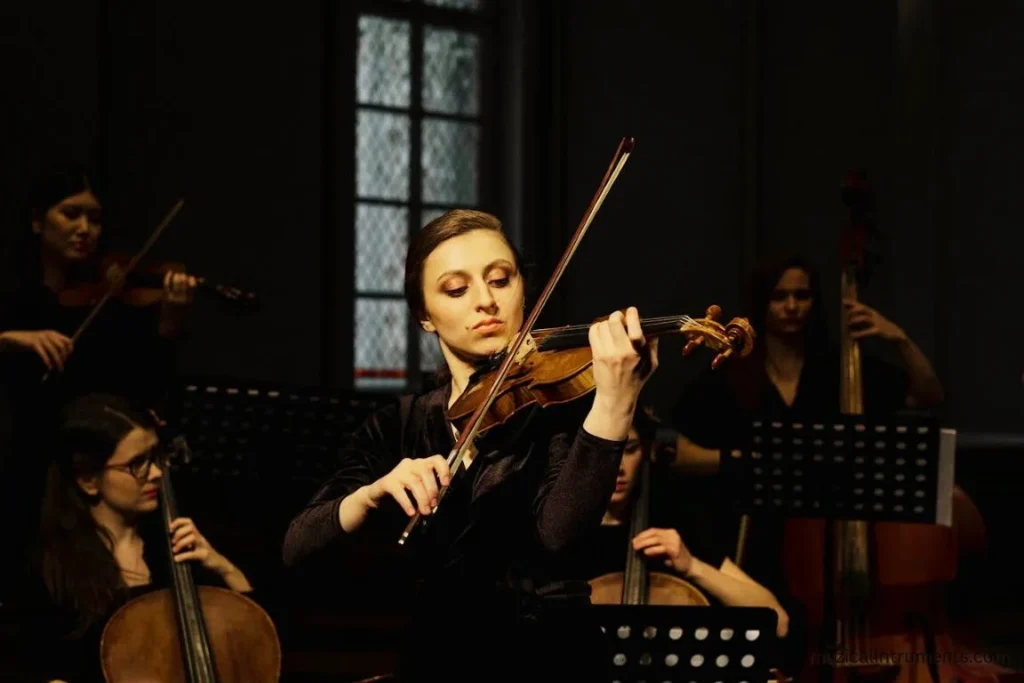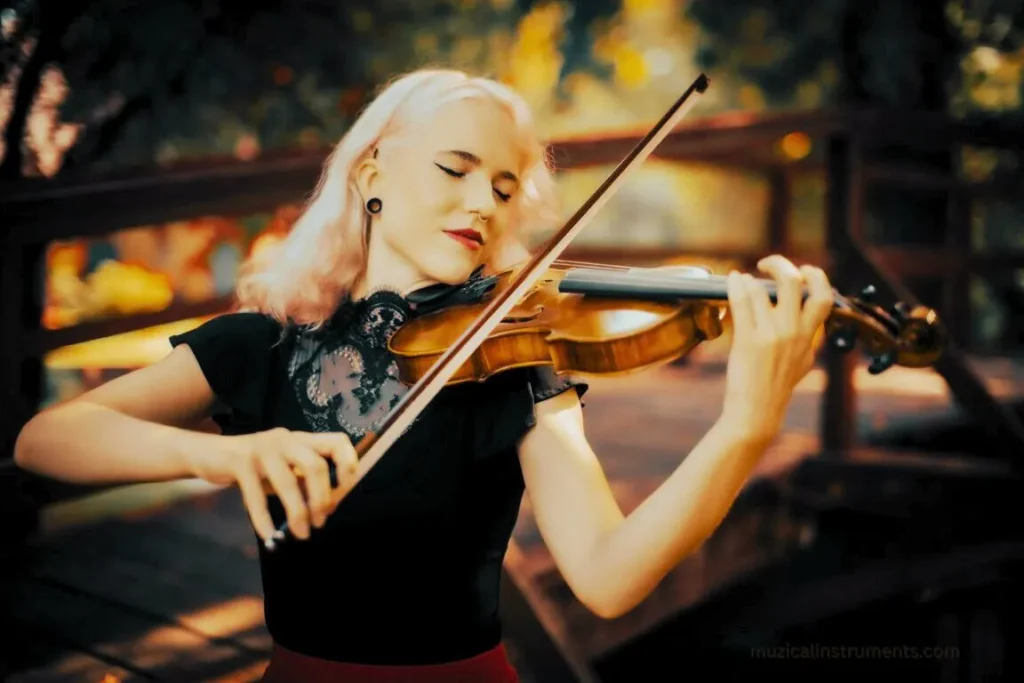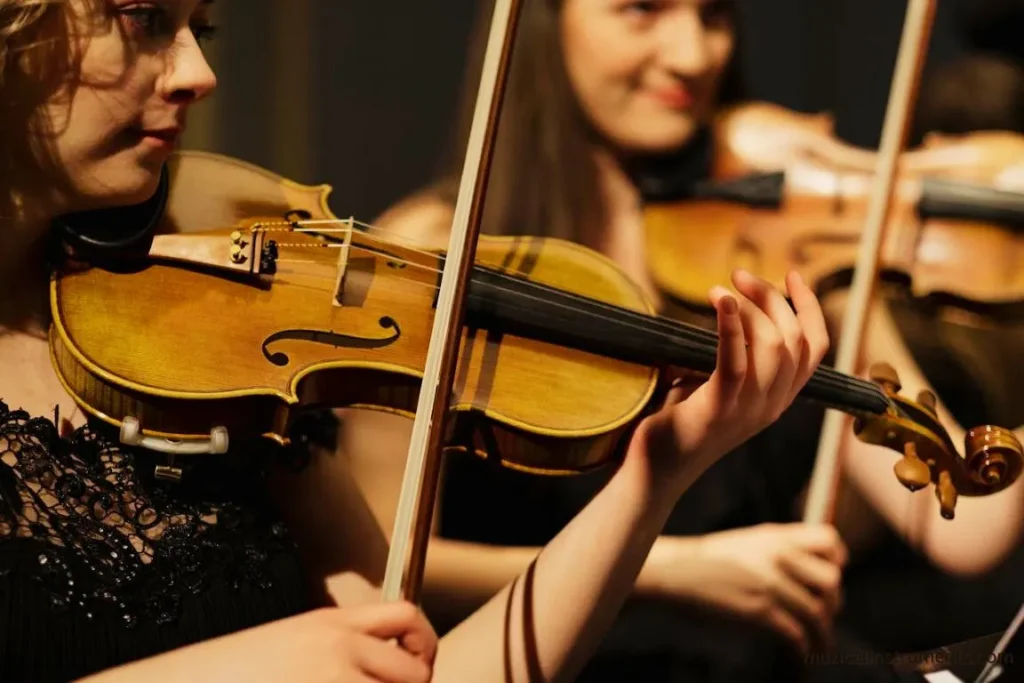Fiddle vs Violin: The Real Difference You’ll Hear and Feel
Fiddle vs violin, what’s the difference? Apparently both of them are same shape. Same sound. But people call them different names. Why?
Here’s the truth: a fiddle and a violin are the same instrument. Both have four strings tuned to G-D-A-E. Both use a bow, a bridge, a fingerboard, and a little round cake of rosin. You tuck it under your chin using a chinrest. You tune it with pegs and fine tuners. On the surface, they look identical.
But the way you play makes all the difference. A violinist often performs classical pieces, usually reading from sheet music. They apply gentle bow pressure, make soft movements, and pour in deep emotion.
A fiddler plays folk, bluegrass, or Irish tunes. They play fast, by ear, with rhythm and fun. Many fiddlers use a flatter bridge and steel strings to help them play fast notes and double stops. That’s how the music dances.
So yes, it’s one instrument, but two very different worlds. Let’s look closer so you can choose your path.
What Is a Violin?

A violin is a small string instrument. You hold it under your chin. You slide a bow across the strings to make sound. It has four strings: G, D, A, and E. It also has a fingerboard, a bridge, a tailpiece, and a chinrest. You use rosin on the bow to help it grip the strings.
The violin is popular in classical music. You’ll hear it in orchestras, chamber music, and even movie soundtracks. A person who plays it is called a violinist. They often read sheet music, follow rules, and play with soft, smooth moves. The sound is rich and full. Many violinists use gut or synthetic strings to make warm tones. The bridge is curved to help play one note at a time.
So, in the fiddle v violin question, this is the violin side. It’s the same instrument, but it follows a different style. It’s more formal. More quiet. More trained. But still full of feeling.
What Is a Fiddle?

Now let’s look at the fiddle.
Here’s the simple truth: a fiddle is a violin. Same body. Same strings. Same bow. But the way it’s played? That’s what sets it apart.
Fiddlers don’t usually play in big concert halls. You’ll find them at street corners, barns, backyard jams, or music festivals. The music is fast, fun, and made to move your feet. Think bluegrass, country, Irish folk, or Appalachian old-time.
A fiddler doesn’t always need sheet music. A lot of them learn by ear. They pick up tunes just by hearing them. And they like to add their own twist, little slides, double stops, quick runs. It’s loose. It’s lively. It’s made for dancing, not just sitting and listening.
Fiddlers often set up their instrument a little different too. Many use steel-core strings, they’re louder and brighter. The bridge might be flatter than a classical one. That makes it easier to hit two strings at once, or switch strings super fast.
So in this whole violin vs fiddle thing, here’s what matters: the fiddle isn’t a new instrument. It’s just a violin living its wild side.
What Do They Have in Common?
So, we’ve talked about the styles. But now let’s look at what’s the same. Because when you see them side by side, he question of the difference between violin and fiddle gets a little clearer.
They both have the same body. Same wood, same size, same shape. Both have four strings, a bow, a bridge, fine tuners, pegs, and a chinrest. The tuning is the same too: G, D, A, and E. Whether you’re playing Mozart or mountain music, the notes don’t change.
You hold them the same way, under your chin, resting on your shoulder. You use rosin on the bow. You press the strings down with your fingers. And the sound comes from pulling the bow across the strings, just like always.
So in the end, when it comes to the actual instrument, there’s no big battle. Fiddle vs violin isn’t about what it is, it’s about what you do with it. That’s where things really start to split.
Fiddle vs Violin: What’s the Real Difference?
| Feature | Violin | Fiddle |
|---|---|---|
| Instrument | Same as a fiddle | Same as a violin |
| Music Style | Classical, orchestra, soft and smooth | Folk, bluegrass, fast and bouncy |
| Player Name | Violinist | Fiddler |
| Sheet Music | Yes, follows notes exactly | Sometimes, but many play by ear |
| Bridge Shape | Curved (for clean, single notes) | Flatter (for quick string changes) |
| Strings | Gut or synthetic (warm tone) | Steel (bright and loud) |
| Sound | Soft, emotional, detailed | Bright, bold, made for dancing |
| Learning Style | Structured, with a teacher | Can be self-taught or learned by ear |
| Where Played | Concert halls, music schools | Festivals, street corners, jam sessions |
Shared Parts and Setup
No matter how you play, a fiddle and a violin have the same parts.
They both have:
- A bow
- Four strings (tuned G–D–A–E)
- A wooden bridge
- A tailpiece
- A fingerboard
- A chinrest
- And they both need rosin for the bow
The setup might change depending on the style. A fiddler might want a flatter bridge and steel strings for speed. A violinist might choose a curved bridge and softer strings for control. But the base instrument? Still the same.
That’s why the violin vs fiddle debate isn’t about the wood, it’s about how you set it up and how you play it.
How Playing Style Makes the Difference
So far, we’ve seen the gear is the same. Same wood. Same strings. Same bow. But when it comes to the way you play it, that’s where the split really shows. If you’re still asking, what’s the difference between fiddle and violin, the answer is found in the performance.

A violinist plays with care. Every move is planned. The bow glides slow and smooth. They sit still. Their sound tells a story, soft, sad, or sweet. They read sheet music and follow it note by note. The goal? Make it perfect.
A fiddler plays with energy. Their body moves with the music. The bow bounces fast. The rhythm pushes forward. Some don’t even read music, they just hear a tune and copy it. They might slide notes or play two strings at once. It’s not about perfect. It’s about feel.
That’s the heart of it. Fiddle vs violin isn’t about looks. It’s about vibe. One is polished. One is wild. But both can make you feel something real.
Styles and Cultures That Use Fiddles
The word fiddle pops up all over the world. And each place plays it in its own way.
- Irish Traditional Fiddle: Fast, bouncy tunes passed down by ear
- Scottish Fiddle: Strong rhythms and clear dance beats
- Appalachian Old-Time: Simple, steady, perfect for foot-tapping
- Texas Swing: Jazzy, smooth, with a country twang
- Zydeco (from Louisiana): Fun, upbeat, often mixed with accordion

And there’s the Hardanger fiddle from Norway. It looks like a violin but has extra strings underneath. They ring out while you play. The sound is sweet and echoey, like it’s playing with itself!
So when people say fiddle vs violin, remember, the word “fiddle” is more about the style and the story behind the music.
Final Thoughts: Fiddle vs Violin, Which One Is Right for You?
So now you know. When people say fiddle vs violin, they’re really talking about how the music feels, not the instrument itself.
If you love soft, pretty songs and want to read sheet music, the violin might be your thing.
If you like toe-tapping, fast tunes and want to play by ear, the fiddle could be your path.
But here’s the best part: you don’t have to pick just one. You can switch styles anytime. You can even do both.
At the end of the day, it’s the same wooden box. What matters is what you do with it.
Curious about technique and comfort? Here’s what you should know about playing violin with long nails and how it affects your grip and sound.
FAQ: Fiddle vs Violin
1. Is a fiddle and a violin the same instrument?
Yes, physically, they are the same instrument. The “fiddle vs violin” debate isn’t about the instrument itself, but the style of music played. “Violin” is the term used for classical music, while “fiddle” is used for folk, bluegrass, or country tunes.
2. Why do people say fiddle instead of violin?
The term “fiddle” feels more informal and fun. In the context of fiddle vs violin, saying “fiddle” often implies a style of playing that is rhythmic, fast, and learned by ear rather than from sheet music. It’s a cultural and stylistic distinction.
3. Can I play classical music on a fiddle?
Absolutely. Since the instrument is identical, the fiddle vs violin distinction doesn’t limit its capability. A fiddle is a violin, so it can be used to play anything from complex orchestra music to simple folk tunes.
4. What’s the difference in how they are played?
The playing style is the core difference in the fiddle vs violin discussion. A classical violinist often uses smooth, long bow strokes and precise vibrato. A fiddler’s style may be more rhythmic and percussive, often featuring faster bowing, slides, and ornamentation like drones.
5. Can a child start with a fiddle?
Yes! When considering fiddle vs violin for a beginner, starting with fiddle tunes can be very engaging. The songs are often catchy and fun, which can build a child’s confidence and love for the instrument.
6. Do I need special lessons for the fiddle vs violin styles?
The foundational skills are the same. However, if you want to master a specific style, the fiddle vs violin choice matters. For specialized genres like Irish or Texas swing fiddle, finding a teacher who knows that specific tradition is highly beneficial.
7. What kind of music uses fiddles?
The “fiddle” side of the fiddle vs violin spectrum covers a huge range of music. You’ll hear fiddles prominently in Irish and Scottish folk, Appalachian old–time, American bluegrass, Texas swing, and Cajun music.
8. What is a Hardanger fiddle?
The Hardanger fiddle is a unique instrument from Norway and is not part of the standard fiddle vs violin debate. It’s a distinct type of violin with extra sympathetic strings that resonate, creating a rich, echoing sound specific to Norwegian folk music.
